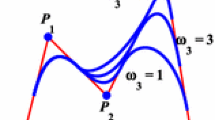Abstract
NURBS curve is one of the most commonly used tools in CAD systems and geometric modeling for its various specialties, which means that its shape is locally adjustable as well as its continuity order, and it can represent a conic curve precisely. But how to do degree reduction of NURBS curves in a fast and efficient way still remains a puzzling problem. By applying the theory of the best uniform approximation of Chebyshev polynomials and the explicit matrix representation of NURBS curves, this paper gives the necessary and sufficient condition for degree reducible NURBS curves in an explicit form. And a new way of doing degree reduction of NURBS curves is also presented, including the multi-degree reduction of a NURBS curve on each knot span and the multi-degree reduction of a whole NURBS curve. This method is easy to carry out, and only involves simple calculations. It provides a new way of doing degree reduction of NURBS curves, which can be widely used in computer graphics and industrial design.
Similar content being viewed by others
References
Piegl, L., Tiller, W., The NURBS Book, Berlin: Springer, 1995.
Piegl, L., Tiller, W., Algorithm for degree reduction of B-spline curves, Computer Aided Design, 1995, 27(2): 101–110.
Wolters, H. J., Wu, G., Farin, G., Degree reduction of B-spline curves, Computing Supplement, 1998, 13: 235–241.
Yong Junhai, Hu Shimin, Sun Jiaguang et al., Degree reduction of B-spline curves, Computer Aided Geometric Design, 2001, 18(2): 117–127.
Yong Junhai, Hu Shimin, Sun Jiaguang, Degree reduction of uniform B-spline curves, Chinese Journal of Computers (in Chinese), 2000, 23(5): 306–310.
Qin Kaihuai, Huang Haikun, New algorithm for degree reduction of B-spline curves, Chinese Journal of Computers (in Chinese), 2000, 23(3): 537–540.
Wang Guojin, Wang Guozhao, Zheng Jianmin, Computer Aided Geometric Design (in Chinese), Beijing: CHEP-Springer, 2001.
Liu Liang, Wang Guojin, Explicit matrix representation for NURBS curves and surface, Computer Aided Geometric Design, 2002, 19(6): 409–419
Fox, L., Parker, I. B., Chebyshev Polynomials in Numerical Analysis, London: Oxford University Press, 1968.
Eck, M., Degree reduction of Bézier curves, Computer Aided Geometric Design, 1993, 10(4): 237–251.
Eck, M., Least squares degree reduction of Bézier curves, Computer Aided Design, 1995, 27(11): 845–851.
Schumaker, L. L., Spline Functions: Basic Theory, New York: Wiley, 1981.
Author information
Authors and Affiliations
Rights and permissions
About this article
Cite this article
Cheng, M., Wang, G. Multi-degree reduction of NURBS curves based on their explicit matrix representation and polynomial approximation theory. Sci China Ser F 47, 44–54 (2004). https://doi.org/10.1360/02yf0229
Received:
Issue Date:
DOI: https://doi.org/10.1360/02yf0229




